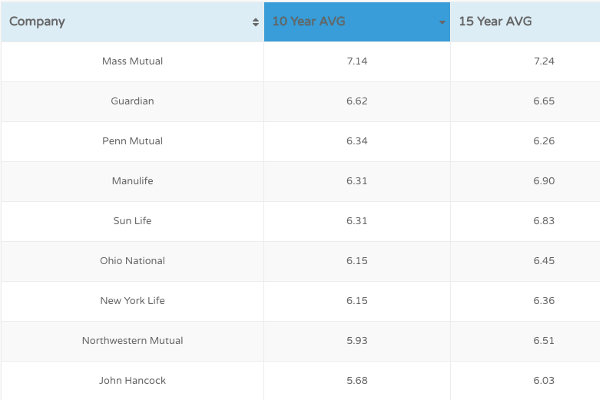Investing in the stock market can be a great way to build wealth, but it also comes with risks and volatility. To mitigate these risks, investors often diversify their portfolios with other assets like bonds, real estate, and commodities. However, there is another asset that is often overlooked but can play a significant role in enhancing the performance of a portfolio: whole life insurance.
In this blog post, we will explore how whole life insurance can complement a stock portfolio and provide additional benefits beyond the traditional life insurance protection.
The cash value of whole life insurance grows tax-deferred and is guaranteed to increase over time, regardless of market conditions. This makes it a reliable asset that can provide stability and predictability to a portfolio.
Whole life insurance policies typically have a guaranteed minimum interest rate, which can range from 2% to 4%. This means that the cash value of the policy will continue to grow, even during periods of low-interest rates.
Additionally, whole life insurance policies allow policyholders to borrow against the cash value of the whole life insurance policy cost. This provides a source of liquidity that can be used for emergencies or to take advantage of investment opportunities.
Click below to get a Quote Now
Get Me A Quote
Furthermore, whole life insurance policies typically offer a dividend, which can increase over time. This dividend can help offset the effects of inflation and provide additional income.
Additionally, whole life insurance can provide protection against unforeseen events, such as disability or long-term care. Many whole life insurance policies offer riders that can be added to the policy to provide additional protection against these events.
Furthermore, whole life insurance policies can be used in estate planning to help reduce estate taxes. By placing the policy in a trust, the death benefit can be excluded from the estate, which can help reduce the tax burden on the heirs.
Click below to get a Quote Now
Get Me A Quote
In this blog post, we will explore how whole life insurance can complement a stock portfolio and provide additional benefits beyond the traditional life insurance protection.
The Basics of Whole Life Insurance
Whole life insurance is a type of permanent life insurance that provides coverage for the entire lifetime of the insured. Unlike term life insurance, which provides coverage for a specified period, whole life insurance builds cash value over time, which can be accessed through loans or withdrawals.The cash value of whole life insurance grows tax-deferred and is guaranteed to increase over time, regardless of market conditions. This makes it a reliable asset that can provide stability and predictability to a portfolio.
Whole Life Insurance as a Bond Alternative
Bonds are often included in portfolios to provide stability and income. However, in today's low-interest-rate environment, the yields on bonds are relatively low. Whole life insurance can be an excellent alternative to bonds, as it offers a more attractive yield and provides additional benefits.Whole life insurance policies typically have a guaranteed minimum interest rate, which can range from 2% to 4%. This means that the cash value of the policy will continue to grow, even during periods of low-interest rates.
Additionally, whole life insurance policies allow policyholders to borrow against the cash value of the whole life insurance policy cost. This provides a source of liquidity that can be used for emergencies or to take advantage of investment opportunities.
Secure Your Future Now! Get Whole Life Insurance Today
Click below to get a Quote Now
Get Me A Quote
Whole Life Insurance as a Hedge Against Inflation
Inflation can erode the value of a portfolio over time. While stocks have historically outperformed inflation, they can still be affected by inflationary pressures. Whole life insurance can be used as a hedge against inflation, as the cash value of the policy grows over time and is not affected by inflation.Furthermore, whole life insurance policies typically offer a dividend, which can increase over time. This dividend can help offset the effects of inflation and provide additional income.
Whole Life Insurance as a Diversifier
Diversification is key to reducing risk in a portfolio. Whole life insurance can be an excellent diversifier, as it is not correlated with the stock market. This means that the performance of the policy is not affected by stock market fluctuations.Additionally, whole life insurance can provide protection against unforeseen events, such as disability or long-term care. Many whole life insurance policies offer riders that can be added to the policy to provide additional protection against these events.
Whole Life Insurance as a Legacy Planning Tool
Finally, whole life insurance can be an excellent tool for legacy planning. When the policyholder passes away, the death benefit is paid out to the beneficiaries tax-free. This can provide a substantial inheritance for loved ones and can be used to pay for final expenses, estate taxes, or to provide income for the surviving spouse or children.Furthermore, whole life insurance policies can be used in estate planning to help reduce estate taxes. By placing the policy in a trust, the death benefit can be excluded from the estate, which can help reduce the tax burden on the heirs.
Conclusion:
Whole life insurance can be an excellent addition to a stock portfolio, providing stability, diversification, and additional benefits beyond traditional life insurance protection. By leveraging the benefits of whole life insurance, investors can turbocharge their portfolios and achieve their financial goals with confidence.Secure Your Future Now! Get Whole Life Insurance Today
Click below to get a Quote Now
Get Me A Quote




